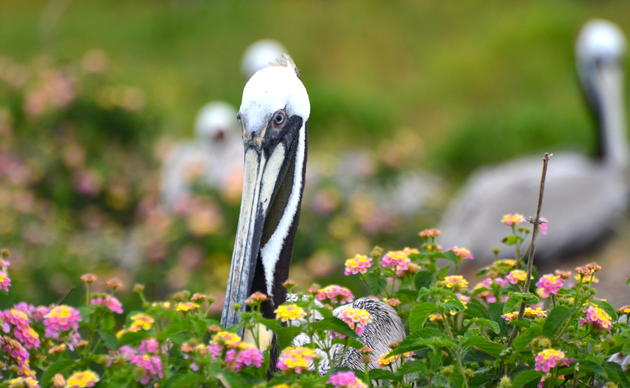Great Egret
A tall, elegant, white bird, the Great Egret is found on every continent except Antartica. The Great Egret is the symbol of the National Audubon Society and its silhouette is featured in Audubon's logo. In the late 19th century, Great Egrets were hunted almost to extinction for their plumes. Outrage over the slaughter of millions of birds sparked conservation movements across the country, eventually leading to the founding of the Massachusetts Audubon Society in 1896. Audubon’s momentum continued to build in the first years of the 20th century. Its members successfully pushed for the passing of the Lacey Act (in 1900), an important piece of bird conservation legislation that effectively stalled the millinery trade and brought many species of waterbirds under protection.
Strictly carnivorous, the Great Egret forages in a variety of marine and freshwater habitats including: mud flats, freshwater and salt marshes, beaches, lagoons, river and creek edges, ponds, lakes, swamps, ditches, canals and aquaculture and rice fields. From 1973 to 1990, the majority (45 to 87%) of the population recorded each year by the Texas Colonial Waterbird Society survey was found in coastal areas. Great Egrets establish colonies in lakes, ponds, marshes, estuaries impoundments and on natural and dredge spoil islands. Nests may be constructed in woody vegetation, shrubs and trees in multi-species colonies and are occasionally found on the ground or on artificial nest platforms. Great Egrets often nest in the highest points in a colony and is regularly one of the first species to arrive- possibly inducing other species to nest at a site.
For more information on Great Egrets, including identifcation tips, visit their page on the Cornell Lab of Ornithology.
Text References
- Telfair, R. 2007. Great Egret. The Texas Breeding Bird Atlas. Texas A&M University System, College Station and Corpus Christi, TX.
- Mcnicholl, M. K., P. E. Lowther, and J. A. Hall. 2001. Forster's Tern (Sterna forsteri).in A. Poole, editor. The Birds of North America Online. Cornell Lab of Ornithology, Ithaca.
How you can help, right now
Join Audubon Texas Today
Becoming a member supports our local work protecting birds and the places they need.
Consider a Legacy Gift for Texas
Planned gifts and bequests allow you to provide a lasting form of support to Audubon Texas.
Subscribe to Our Newsletter
Subscribe to our newsletter for updates about Audubon Texas's conservation work, and news about our activities and local events.




